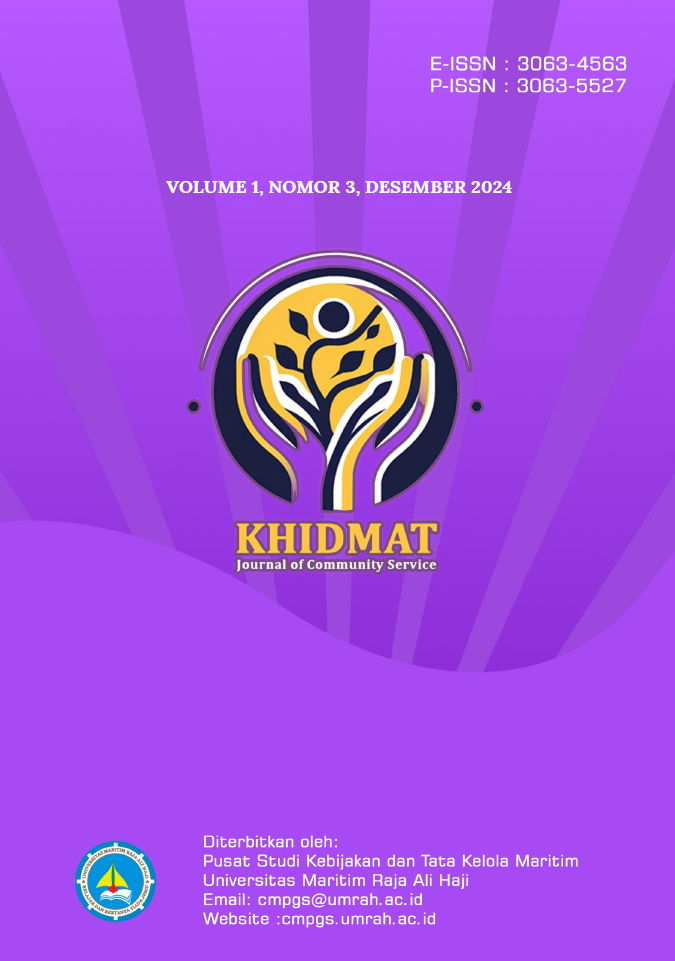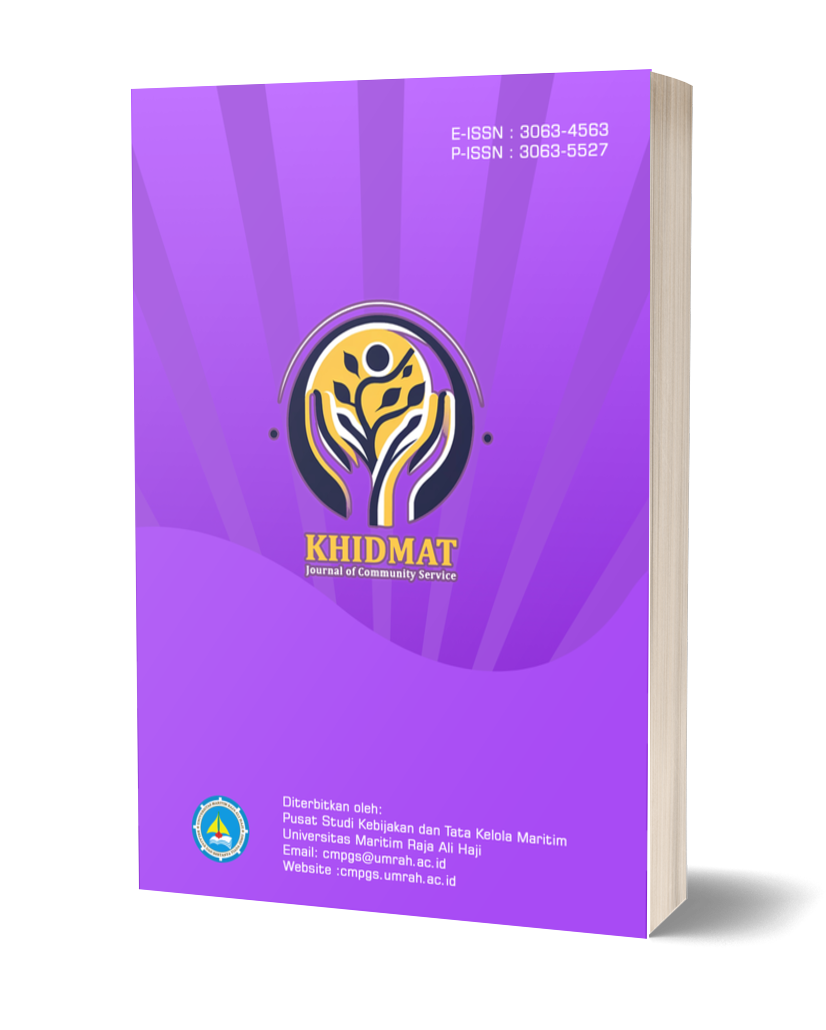Pengaruh Penggunaan CAD atau CAM terhadap Hasil Belajar Siswa pada Mata Pelajaran CNC
DOI:
https://doi.org/10.31629/khidmat.v1i3.7039Keywords:
Computer Aided Design (CAD), CNC, Pendidikan KejuruanAbstract
Artikel ini bertujuan untuk mengevaluasi pengaruh penggunaan perangkat lunak Computer-Aided Design (CAD) dan Computer-Aided Manufacturing (CAM) terhadap hasil belajar siswa pada mata pelajaran Computer Numerical Control (CNC) di Sekolah Menengah Kejuruan (SMK). Metode yang digunakan adalah eksperimen dengan desain kelompok kontrol, melibatkan dua kelas dari SMK Negeri 3 Tanjungpinang, yaitu kelas eksperimen (menggunakan CAD/CAM) dan kelas kontrol (tanpa CAD/CAM). Setiap kelas terdiri dari 34 siswa. Hasil penelitian menunjukkan bahwa kelas eksperimen memiliki nilai rata-rata yang lebih tinggi (67,04) dibandingkan kelas kontrol (63,31), dengan selisih signifikan sebesar 3,73 poin. Data statistik juga menunjukkan bahwa kelompok eksperimen memiliki distribusi nilai yang lebih homogen, dengan standar deviasi lebih rendah (3,06) dibandingkan kelompok kontrol (5,13), yang mengindikasikan efektivitas penggunaan CAD/CAM dalam pembelajaran. Penggunaan CAD/CAM terbukti meningkatkan pemahaman siswa terhadap desain mekanik, visualisasi proses pemesinan, serta kemampuan praktis dalam pemrograman CNC. Integrasi teknologi ini tidak hanya relevan dengan tuntutan Industri 4.0 tetapi juga meningkatkan keterlibatan siswa dan mempersiapkan mereka menghadapi dunia kerja modern. Penulis merekomendasikan penerapan CAD/CAM secara lebih luas dalam kurikulum SMK, dengan dukungan pelatihan guru, investasi perangkat lunak, dan kerja sama dengan industri untuk memperluas peluang magang siswa. Selain itu, penelitian lebih lanjut dapat mengeksplorasi penggunaan teknologi berbasis Virtual Reality (VR) dan Augmented Reality (AR) dalam pembelajaran CNC untuk meningkatkan efektivitas dan kreativitas siswa.
Downloads
References
Ahmed, U., Lin, J. C. W., & Srivastava, G. (2023). Exploring the Potential of Cyber Manufacturing System in the Digital Age. ACM Transactions on Internet Technology, 23(4). https://doi.org/10.1145/3596602
Bilalis, L., Canellidis, V., Papatheodorou, T., & Giannatsis, J. (2022). Direct Digital Manufacturing of a Customized Face Mask. Journal of Manufacturing and Materials Processing, 6(5). https://doi.org/10.3390/jmmp6050126
Delcker, J. (2023). Digitalisation in the Curricula of Vocational Schools: Text Mining as an Instrument of Curricula Analysis. Technology, Knowledge and Learning, 28(3), 999–1014. https://doi.org/10.1007/s10758-022-09591-0
Donkin, R., & Kynn, M. (2021). Does the learning space matter? An evaluation of active learning in a purpose-built technology-rich collaboration studio. Australasian Journal of Educational Technology, 37(1), 133–146. https://doi.org/10.14742/ajet.5872
Hua, L., Huang, N., Yi, B., Zhao, Y., & Zhu, L. (2023). Global toolpath smoothing for CNC machining based on B-spline approximation with tool tip position adjustment. International Journal of Advanced Manufacturing Technology, 125(7–8), 3651–3665. https://doi.org/10.1007/s00170-023-11033-9
Jia, S., Yuan, Q., Cai, W., Yuan, Q., Liu, C., Lv, J., & Zhang, Z. (2018). Establishment of an improved material-drilling power model to support energy management of drilling processes. Energies, 11(8), 0–16. https://doi.org/10.3390/en11082013
Kovalenko, I., Moyne, J., Bi, M., Balta, E. F. E. C., Ma, W., Qamsane, Y., Zhu, X., Mao, Z. M., Tilbury, D. M., & Barton, K. (2022). Toward an Automated Learning Control Architecture for Cyber-Physical Manufacturing Systems. IEEE Access, 10, 38755–38773. https://doi.org/10.1109/ACCESS.2022.3165551
Kugalur Palanisamy, N., Rivière Lorphèvre, E., Gobert, M., Briffoteaux, G., Tuyttens, D., Arrazola, P. J., & Ducobu, F. (2022). Identification of the Parameter Values of the Constitutive and Friction Models in Machining Using EGO Algorithm: Application to Ti6Al4V. Metals, 12(6), 1–21. https://doi.org/10.3390/met12060976
Leavy, A., Dick, L., Meletiou-Mavrotheris, M., Paparistodemou, E., & Stylianou, E. (2023). The prevalence and use of emerging technologies in STEAM education: A systematic review of the literature. Journal of Computer Assisted Learning, 39(4), 1061–1082. https://doi.org/10.1111/jcal.12806
Mulders, M., Buchner, J., & Kerres, M. (2024). Virtual Reality in Vocational Training: A Study Demonstrating the Potential of a VR-based Vehicle Painting Simulator for Skills Acquisition in Apprenticeship Training. Technology, Knowledge and Learning, 29(2), 697–712. https://doi.org/10.1007/s10758-022-09630-w
Niessen, F., John, M., & Nancarrow, B. (2019). machining of complex micro- and nano-structures.
Oguzor, N. S. (2011). Computer usage as instructional resources for vocational training in Nigeria. Educational Research and Reviews, 6(5), 395–402. https://doi.org/10.6007/ijarbss.v1i2.16
Ouyang, F., Wu, M., Zheng, L., Zhang, L., & Jiao, P. (2023). Integration of artificial intelligence performance prediction and learning analytics to improve student learning in online engineering course. International Journal of Educational Technology in Higher Education, 20(1), 1–23. https://doi.org/10.1186/s41239-022-00372-4
Visvizi, A., & Daniela, L. (2019). Technology-enhanced learning and the pursuit of sustainability. Sustainability (Switzerland), 11(15), 1–7. https://doi.org/10.3390/su11154022
Wang, C., Zhang, Y., Ding, H., Z. (2023). Applied Mathematics and Nonlinear Sciences. Applied Mathematics and Nonlinear Sciences, 8(2), 3383–3392.
Wen, J., Xie, F., Liu, X., & Yue, Y. (2023). Evolution and Development Trend Prospect of Metal Milling Equipment. Chinese Journal of Mechanical Engineering (English Edition), 36(1). https://doi.org/10.1186/s10033-023-00865-x
Wiyono, B. B., Samsudin, Imron, A., & Arifin, I. (2022). The Effectiveness of Utilizing Information and Communication Technology in Instructional Supervision with Collegial Discussion Techniques for the Teacher’s Instructional Process and the Student’s Learning Outcomes. Sustainability (Switzerland), 14(9). https://doi.org/10.3390/su14094865
Wosnik, M., Kramer, C., Selig, A., & Klemm, P. (2006). Enabling feedback of process data by use of STEP-NC. International Journal of Computer Integrated Manufacturing, 19(6), 559–569. https://doi.org/10.1080/09511920600622080
Yildiz, M., Shi, R., & Kara, M. (2022). How to improve the design of experimental studies in computing education: Evidence from the international assessments. Education and Information Technologies, 27(4), 5075–5102. https://doi.org/10.1007/s10639-021-10800-z
Zhan, Z., Yao, X., & Li, T. (2023). Effects of association interventions on students’ creative thinking, aptitude, empathy, and design scheme in a STEAM course: considering remote and close association. International Journal of Technology and Design Education, 33(5), 1773–1795. https://doi.org/10.1007/s10798-022-09801-x
Downloads
Published
Issue
Section
License
Copyright (c) 2024 Fitrinaldi Fitrinaldi, Khairi Rosadi, Faridl M. Husain, Taufik Hidayat, Desi Rahmatina, Encik Abdulhajar

This work is licensed under a Creative Commons Attribution-ShareAlike 4.0 International License.
Anda bebas untuk:
- Berbagi — menyalin dan mendistribusikan ulang materi dalam media atau format apa pun untuk tujuan apa pun, bahkan secara komersial.
- Mengadaptasi — mencampur, mengubah, dan membuat materi untuk tujuan apa pun, bahkan secara komersial.
- Pemberi lisensi tidak dapat mencabut kebebasan ini selama Anda mengikuti ketentuan lisensi.
Berdasarkan ketentuan berikut:
- Atribusi — Anda harus memberikan penghargaan yang sesuai, menyediakan tautan ke lisensi, dan menunjukkan jika ada perubahan yang dilakukan. Anda dapat melakukannya dengan cara yang wajar, tetapi tidak dengan cara yang menunjukkan bahwa pemberi lisensi mendukung Anda atau penggunaan Anda.
- BerbagiSerupa — Jika Anda mencampur, mengubah, atau membuat materi, Anda harus mendistribusikan kontribusi Anda di bawah lisensi yang sama dengan aslinya.
- Tidak ada batasan tambahan — Anda tidak boleh menerapkan ketentuan hukum atau tindakan teknologi yang secara hukum membatasi orang lain untuk melakukan apa pun yang diizinkan oleh lisensi.
















